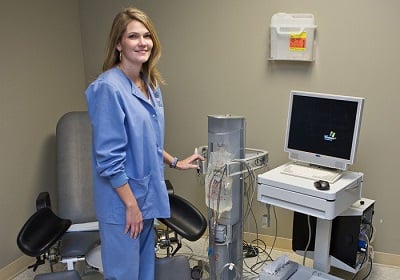 Disorders that affect the lower urinary tract are commonly diagnosed via a urodynamic stidu. If the disorder is not properly diagnosed, treatment is likely to fail. Here, a research study will be reviewed in which the value of urodynamic testing for diagnosing the causes of lower urinary symptoms in male patients was examined.
Disorders that affect the lower urinary tract are commonly diagnosed via a urodynamic stidu. If the disorder is not properly diagnosed, treatment is likely to fail. Here, a research study will be reviewed in which the value of urodynamic testing for diagnosing the causes of lower urinary symptoms in male patients was examined.
In 2016, Nephro-urology Monthly published the study entitled The Value of Urodynamic Study for Diagnosing the Causes of Lower Urinary Tract Symptoms in Male Patients: A Study from Iran. Head researcher Alireza Ghadian sought to determine the utility of urodynamic testing, particularly uroflowmetry, measurement of the filling and voiding phases, post-void urine retention, and detrusor pressure measurements.
This study was undertaken due to the worldwide phenomenon of an aging population, which has lead to nearly 73% of males in Western communities complaining of at least one lower urinary tract symptom. The main treatment option for these disorders is surgery; however, if the problem is not properly diagnosed this course of treatment will not be successful. Urodynamic testing is the gold standard for determining the pathology of the urinary system.
For this study, 407 male patients (mean age 50.88 years) with lower urinary tract symptoms were recruited to participate between April 2011 and March 2013. Data collected from each patient included his primary complaint, symptoms of the illness, past medical history, and laboratory and imaging results, as well as a fully urodynamic assessment. The most common complaint among patients was urinary frequency (28.8%).
Filling Phase Results
Each patient’s systometric capacity was measured via gradual filling of the bladder with a saline injection. The mean systometric capacity for patients was 366 + 0.97 mL. To diagnose obstruction intensity, maximum detrusor pressure measurements were acquired. For pressure values higher than 40 cm H2O, obstruction was likely. Among study participants, 49.88% of patients had an obstruction.
Additionally, 50% of the patients had normal detrusor function, 31% had overactive detrusor function, and 19% had hypoactive detrusor function. When electromyography tests were performed, 90.68% of patients had normal electric potential in the depolarized muscles of the perineum, while 9.32% of patients had detrusor-external sphincter dyssenergia.
Uroflowmetry and Voiding Phase Results
The majority of patients (53.07%) had bell-shaped and intermittent voiding. The maximum speed of urine flow was found to be normal in 47.02% of patients. Average urine volume in all patients was higher than normal, at 187 + 3.3 mL, while residual urine volume was found to be 130 + 2.49 mL.
Association of Symptoms and Urodynamic Findings
Overall the most common disorders that were diagnosed were bladder sensation disorder, in 34.06% of patients; overactive bladder in 23.28% of patients; and bladder outlet obstruction in 12.74% of patients. Ultimately, 10.54% of patients had normal findings on their urodynamic tests.
Discussion
These studies shed light on the importance of urodynamic testing. The most common urinary complaint was frequency, which is consistent with other studies. In the uroflowmetry portion of this study, the most common pattern was a bell-shaped diagram and intermittency which suggests that in spite of urinary system complaints, this test can have normal results and should not exclude voiding disorders. Additionally, maximum flow rates should not be used to rule out voiding issues, as Qmax values were normal in nearly half of all patients.
Bladder compliance was found to be appropriate at the expected filling volume; however, reduced compliance was observed in 13% of patients, which can be dangerous for the upper urinary tract.
For patients with bladder sense disorders, the most common complaint was early sensation. From EMG studies, it was found that fewer than 10% of patients had no coordination between detrusor and sphincter function.
The authors of this study suggest that physicians should consider underlying disease when making an early diagnosis, such as type II diabetes, when diagnosing disorders such as overactive bladder.
Overall, bladder sensation disorder was the most common finding from this study, whereas bladder outlet obstruction is most commonly diagnosed among this demographic of patients. An important finding was that the total frequency of bladder sensation disorder and overactive bladder as diagnosed by urodynamic testing was the same as the number of patients who were presented with complaints of these disorders.
Ultimately, the researchers in this study found that urodynamic testing is essential, particularly when carried out prior to surgery, in order to reduce the chances of making an incorrect diagnosis. Treatment solely based on a patient’s complaints is likely to fail.
If you want to improve the urodynamics testing in your practice, click on the button below to get more information. Your patients will benefit and your practices will benefit.
References
- Heydari, F., Rezadoust, B., Abbaszade, S., Jahan Afrouz, E., & Ghadian, A. (2016). The Value of Urodynamic Study for Diagnosing the Causes of Lower Urinary Tract Symptoms in Male Patients: A Study From Iran. Nephro-Urology Monthly, 8(4), e34342. http://doi.org/10.5812/numonthly.34342 Link
- Jamzadeh AE, Xie D, Laudano M, Seklehner S, Elterman DS, Shtromvaser L, et al. Urodynamic characterization of lower urinary tract symptoms in men less than 40 years of age. World J Urol. 2014;32(2):469–73. doi: 10.1007/s00345-013-1134-z Link
- Liu RT, Chung MS, Lee WC, Chang SW, Huang ST, Yang KD, et al. Prevalence of overactive bladder and associated risk factors in 1359 patients with type 2 diabetes. Urology. 2011;78(5):1040–5. doi: 10.1016/j.urology.2011.05.017 Link


